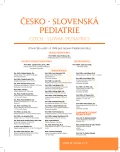Pepsin in secretion from the upper respiratory tract as a marker of extraesophageal reflux in children
Authors:
T. Strachan 1,2; J. Melter 2; A. Barabasová 2; M. Miškovská 2; P. Ferenc 2; J. Fábry 2; Peter Bánovčin 1
Authors‘ workplace:
Klinika detí a dorastu Jesseniovej lekárskej fakulty Univerzity Komenského v Bratislave a Univerzitnej nemocnice, Martin
1; Šrobárov ústav detskej tuberkulózy a respiračných chorôb, n. o., a Klinika detskej TBC a respiračných chorôb JLF UK, Dolný Smokovec
2
Published in:
Čes-slov Pediat 2017; 72 (3): 176-181.
Category:
Original Papers
Overview
Objective:
Extraesophageal symptoms of gastroesophageal reflux disease (GERD) represent a diverse group of symptoms and diseases. It is assumed that these symptoms and diseases are formed, maintained or aggravated by reflux. Our aim was to highlight the issue of extraesophageal reflux (EER) among children and to present our experience with investigations of pepsin in saliva by the immunochromatographic method – PeptestTM.
Methods:
The research was done through two different groups of patients. In the first group of 39 pediatric patients with suspected GERD we correlated the results between 24-hour esophageal pH monitoring and Peptest. The second group consisted of 62 children with suspected EER - all underwent the laryngeal examination by an ENT specialist and quantitative examination of pepsin levels in two saliva samples. Outcomes of these investigations were correlated with clinical difficulties of pediatric patients.
Results:
In the first group, 17 patients out of 39 were found to have an abnormal pH monitoring. At least one positive pepsin (PeptestTM) result was seen in 82.4% of them. Conversely, 90.9% of patients with physiological pH records had positive at least one saliva sample.
In the second group was pepsin in saliva confirmed in all 62 children with suspected EER. 50% of all samples of saliva showed high pepsin levels (>500 ng/ml). Higher pepsin levels in saliva have been reported in patients with associated ENT finding (laryngitis posterior, chronic pharyngitis). We have not noticed a significant correlation between the pepsin levels in saliva and the incidence of individual symptoms. The most common symptoms of our EER-positive pediatric patients were excessive production of phlegm in the throat and the need cleared his throat (cough).
Conclusion:
We did not find a direct correlation between 24-h pH monitoring and pepsin detection in saliva in children. Peptest sensitivity due to the pH monitoring was 82.4%. The specificity of the test have not been established because of the absence a control group. However, up to 90.9% of patients with physiological pH records had positive pepsin in saliva. A much closer relationship seems to be between clinical sign of EER and pepsin detection (in our cohort the sensitivity of the Peptest was 100%). Therefore, if suspected extraesophageal reflux in children we prefer testing saliva or sputum for the presence of pepsin over traditional 24-hour pH monitoring.
KEY WORDS:
extraesophageal reflux, pepsin in the saliva
Sources
1. North American Society for Pediatric Gastroenterology, Hepatology and Nutrition and European Society For Pediatric Gastroenterology, Hepatology and Nutrition. Pediatric gastroesophageal reflux clinical practice guidelines. J Pediatr Gastroenterol Nutr 2009; 49: 501. ISSN0277-2116.
2. Toohill RJ. History of extra-esophageal reflux. In: Effects, Diagnosis and Management of Extra-Esophageal Reflux. New York: Nova Science Publisher, 2011: 1–10.
3. Banovcin P Jr, Halicka J, Halickova M, et al. M. Studies on the regulation of transient lower esophageal sphincter relaxations (TLESRs) by acid in the esophagus and stomach. Dis Esophagus 2015; Apr 15. doi: 10.1111/dote.12357. [Epub ahead of print].
4. Halicka J, Banovcin P Jr, Halickova M, et al. Acid infusion into the esophagus increases the number of meal-induced transient lower esophageal sphincter relaxations (TLESRs) in healthy volunteers. Neurogastroenterol Motil 2014 Oct; 26 (10): 1469–1476. doi: 10.1111//nmo.12409. Epub 2014 Aug 22.
5. Zeleník K, Čáp P, Chlumský J, a kol. Mimojícnové projevy refluxní choroby. 1. vyd. Havlíčkův Brod: Tobiáš, Medicína hlavy a krku, 2013: 23–285. ISBN 978-80-7311-138-0.
6. Koufman JA. The otolaryngologic manifestations of gastroesophageal reflux disease (GERD): a clinical investigation of 225 patients using ambulatory 24-hour pH monitoring and an experimental investigation of the role of acid and pepsin in the development of laryngeal injury. Laryngoscope 1991; 101 (53): 1–78.
7. Johnston N, Knight J, Dettmar PW, et al. Pepsin and carbonic anhydrase isoenzyme III as diagnostic markers for laryngopharyngeal reflux disease. Laryngoscope 2004; 114 (12): 2129–2134.
8. Johnston N, Wells CW, Samuels TL, Blumin JH. Pepsin in nonacidic refluxate can damage hypopharyngeal epithelial cells. Ann Otol Rhinol Laryngol 2009; 118 (9): 677–685.
9. Hayat JO, Gabieta-Somnez S, Yazaki E, et al. Pepsin in saliva for the diagnosis of gastro-esophageal reflux disease. Gut 2015; 64 (3): 373–380.
10. Strugala V, Avis J, Jolliffe IG, et al. The role of an alginate suspension on pepsin and bile acids - key aggressors in the gastric refluxate. Does this have implications for the treatment of gastro-oesophageal reflux disease? J Pharm Pharmacol 2009; 61 (8): 1021–1028.
11. Yuksel ES, Hong S-KS, Strugala V, et al. Rapid salivary pepsin test: blinded assessment of test performance in gastroesophageal reflux disease. Laryngoscope 2012; 122 (6): 1312–1316.
12. Ocak E, Kubat G, Yorulmaz İ. Immunoserologic pepsin detection in the saliva as a noninvasive rapid diagnostic test for laryngopharyngeal reflux. Balkan Med J 2015; 32: 46–50.
13. Sifrim D. The role of salivary pepsin in the diagnosis of reflux. Gastroenterology & Hepatology 2015; 11 (6): 417.
Labels
Neonatology Paediatrics General practitioner for children and adolescentsArticle was published in
Czech-Slovak Pediatrics

2017 Issue 3
Most read in this issue
- Patello-femoral disorders in children
- Legg-Calve-Perthes disease
- Pepsin in secretion from the upper respiratory tract as a marker of extraesophageal reflux in children
- RSV infection in late preterm infants
